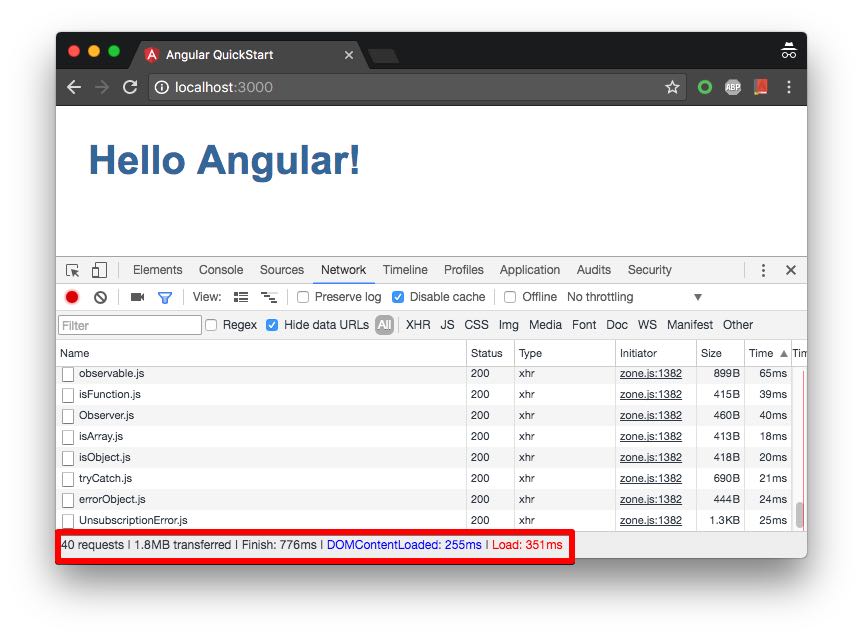为生产环境编译 Angular 2 应用
Angular 2 已经发布了 2.1.2 版本, 相信很多人已经在使用(试用)了, 相比 AngularJS 1.x , Angular 2 在性能上有了长足的进步, 同时 Angular 2 也变得非常的庞大, 动辄几兆的脚本, 如何部署到生产环境? 接下来就介绍如何为生产环境编译 Angular 2 应用, 在本文中, 我们将 Angular 2 官方文档中的 Hello Angular 应用编译到 50K 以下, 以用于生产环境。
未经优化的应用
根据 Angular2 官方的 QuickStart 快速创建一个 Hello Angular 应用, 在没有任何优化的情况下, 运行情况如下图所示:

从上图可以看出, 仅仅一个 Hello 应用, 就产生了 40 个请求, 加载了 1.8M 的脚本, 这个在生产环境下(特别是移动端)是无法接受的。
要看这一步的完整源代码, 请移步 GitHub 。
打包与压缩
传统的方式无非就是进行打包和压缩, 我使用 browserify 和 uglifyjs 来进行打包与压缩, 首先是安装这两个工具类库:
npm i -D browserify uglifyjs
在 package.json 文件中添加这两个 npm 命令:
{
"scripts": {
"bundle": "browserify -s main app/main.js > dist/bundle.js",
"minify": "uglifyjs dist/bundle.js --screw-ie8 --compress --mangle --output dist/bundle.min.js"
}
}
现在运行这两个命令, 看看会怎么样:
npm run bundle && npm run minify
经过一大堆 WARN 之后, 没有出现 ERROR , 也没有出现 npm-debug.log 文件, 证明没有错误, 现在来分析一下大小:
ls -hl dist
-rw-r--r-- 1 zhang staff 1.4M Nov 14 14:08 bundle.js
-rw-r--r-- 1 zhang staff 528K Nov 14 14:10 bundle.min.js
bundle.js 有 1.4M , 不过 bundle.min.js 被压缩到了 528K , 看起来还不错, 还可以再优化一下, 那就是 gzip 压缩, 通常在服务器上都会启用:
gzip dist/bundle.min.js -c > dist/bundle.min.js.gz && ls -hl dist
-rw-r--r-- 1 zhang staff 1.4M Nov 14 14:08 bundle.js
-rw-r--r-- 1 zhang staff 528K Nov 14 14:10 bundle.min.js
-rw-r--r-- 1 zhang staff 129K Nov 14 14:15 bundle.min.js.gz
经过 gzip 之后, bundle.min.js.gz 有 129K , 似乎应该可以了吧? 但是我觉得还有优化的空间。
要看这一步的完整源代码, 请移步 GitHub 。
AOT 以及 Tree Shaking
ES2016 (ES6) 有一个很重要的特性, 那就是 Tree Shaking , 可以移除项目中不需要的部分, 接下来我们使用 rollup 进行 Tree Shaking 。
为了能够使用 Tree Shaking , 我们需要将项目中的 TypeScript 编译成 ES2015 脚本, 需要修改 TypeScript 配置, 新建一个 tsconfig-es2015.json 的配置文件, 内容如下:
{
"compilerOptions": {
"target": "es2015",
"module": "es2015",
"moduleResolution": "node",
"declaration": false,
"removeComments": true,
"noLib": false,
"emitDecoratorMetadata": true,
"experimentalDecorators": true,
"lib": ["es6", "es2015", "dom"],
"sourceMap": true,
"pretty": true,
"allowUnreachableCode": false,
"allowUnusedLabels": false,
"noImplicitAny": true,
"noImplicitReturns": true,
"noImplicitUseStrict": false,
"noFallthroughCasesInSwitch": true,
"typeRoots": [
"./node_modules/@types",
"./node_modules"
],
"types": [
]
},
"files": [
"app/main-aot.ts"
]
}
在 Angular2 应用中, 包含了一个即时编辑器 (JIT) , 在预编译好的应用中不是必需的, 使用 Angular2 的 AOT 编译可以移除即时编译器 (JIT) , 因此需要先安装 Angular 的编译器:
npm i -D @angular/compiler-cli
为了使用 aot 编译出来的文件, main.ts 文件也要做相应的修改, 将 main.ts 文件另存为 main-aot.ts , 修改内容如下:
import { enableProdMode } from '@angular/core';
import { platformBrowser } from '@angular/platform-browser';
import { AppModuleNgFactory } from './app.module.ngfactory';
enableProdMode();
const platform = platformBrowser();
platform.bootstrapModuleFactory(AppModuleNgFactory);
不再使用 platform-browser-dynamic , 改为使用 platform-browser 。
同时 index.html 也另存为 index-aot.html , 也做相应的修改, 不在加载 system.js , 改为直接使用最终的 aot 脚本:
<!--
<script src="node_modules/systemjs/dist/system.src.js"></script>
-->
<!-- 2. Configure SystemJS -->
<!--
<script src="systemjs.config.js"></script>
<script>
System.import('app').catch(function(err){ console.error(err); });
</script>
-->
</head>
<!-- 3. Display the application -->
<body>
<my-app>Loading...</my-app>
<script src="dist/bundle-aot.min.js"></script>
</body>
接下来的整体的思路是:
-
使用 ngc 进行 aot 编译;
npm run ngc -- -p tsconfig-es2015.json这一步将会生成一系列
*.ngfactory.ts*.module.metadata.json临时文件, 可以更新.gitignore来忽略这些文件, 避免对代码库造成污染; -
将 typescript 文件编译成 es2015 (es6) 脚本;
npm run tsc -- -p tsconfig-es2015.json -
使用 rollup 进行 tree shaking , 移除项目不使用的功能;
rollup -f iife -c rollup.config.js -o dist/bundle-aot-es2015.js -
再次使用 typescript 将 tree shaking 之后的脚本编译成 es5 脚本;
tsc --target es5 --allowJs dist/bundle-aot-es2015.js -out dist/bundle-aot.js -
使用 uglifyjs 再次压缩上一部生成的 es5 脚本;
uglifyjs dist/bundle-aot.js --screw-ie8 --compress --mangle --output dist/bundle-aot.min.js
这几个命令对应的 npm 脚本如下:
{
"scripts": {
"ngc": "ngc",
"rollup": "rollup -f iife -c rollup.config.js -o dist/bundle-aot-es2015.js",
"es5": "tsc --target es5 --allowJs dist/bundle-aot-es2015.js -out dist/bundle-aot.js",
"minify-aot": "uglifyjs dist/bundle-aot.js --screw-ie8 --compress --mangle --output dist/bundle-aot.min.js",
"prod-aot": "npm run ngc -- -p tsconfig-es2015.json && npm run tsc -- -p tsconfig-es2015.json && rollup && npm run es5 && npm run minify-aot"
}
}
最终只要运行一个命令即可:
npm run prod-aot
最后来看一下最终的文件大小:
ls -hl
-rw-r--r-- 1 zhang staff 595K Nov 14 15:59 bundle-aot-es2015.js
-rw-r--r-- 1 zhang staff 669K Nov 14 16:01 bundle-aot.js
-rw-r--r-- 1 zhang staff 194K Nov 14 16:01 bundle-aot.min.js
-rw-r--r-- 1 zhang staff 46K Nov 14 16:02 bundle-aot.min.js.gz
-rw-r--r-- 1 zhang staff 1.4M Nov 14 15:54 bundle.js
-rw-r--r-- 1 zhang staff 528K Nov 14 15:54 bundle.min.js
-rw-r--r-- 1 zhang staff 129K Nov 14 16:02 bundle.min.js.gz
最终生成的 bundle-aot.min.js.gz 只有 46K , 比没有使用 aot 编译的最终文件 bundle.min.js.gz 少了将近 2/3 , 可以说 aot + tree shaking 效果非常的显著。
要看这一步的完整源代码, 请移步 GitHub 。
经过这样的终极编译优化编译之后, 应该可以放心的部署到生产环境了。
参考资料: